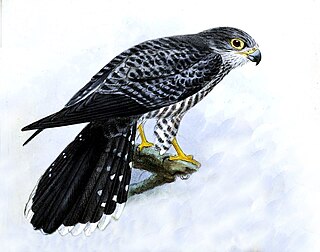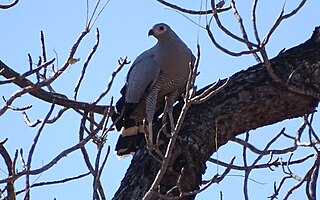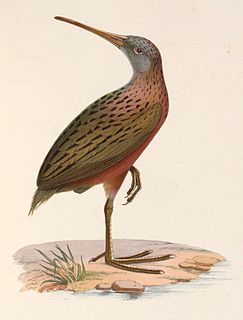
The water pipit is a small passerine bird which breeds in the mountains of Southern Europe and the Palearctic eastwards to China. It is a short-distance migrant; many birds move to lower altitudes or wet open lowlands in winter.

The sharp-shinned hawk is a small hawk, with males being the smallest hawks in the United States and Canada, but with the species averaging larger than some Neotropical species, such as the tiny hawk. The taxonomy is far from resolved, with some authorities considering the southern taxa to represent three separate species: white-breasted hawk, plain-breasted hawk, and rufous-thighed hawk. The American Ornithological Society keeps all four variations conspecific.

The long-tailed hawk is an African bird of prey in the family Accipitridae. It is the only member of the genus Urotriorchis.
The Karthala scops owl, also known as the Grand Comoro scops owl or Comoro scops owl, is a small, scops owl endemic to the island of Grande Comore in the Comoro Islands.

The squirrel cuckoo is a large and active species of cuckoo found in wooded habitats from northwestern Mexico to northern Argentina and Uruguay, and on Trinidad. Some authorities have split off the western Mexican form as the Mexican squirrel-cuckoo.

The Madagascar owl, also known as the Madagascan owl or Madagascar long-eared owl, is a medium-sized owl endemic to the island of Madagascar. It is sometimes considered to be conspecific with the long-eared owl.

The Pacific baza, also known as the crested hawk, crested baza, and Pacific cuckoo-falcon, is a slender, medium-sized species of hawk in the family Accipitridae. It is mostly grey, brown, and white coloured and grows to a length of 35–46 centimetres (14–18 in). It is an omnivore and usually does not migrate. The breeding season for the species lasts from September to at least February, during which time specimens commonly fly and vocalise for display. It lives in Australia, Indonesia, Papua New Guinea, Solomon Islands, and East Timor, in forests, savannas, and freshwater bodies. The International Union for Conservation of Nature lists it as a least concern species.

The banded kestrel is a bird of prey belonging to the falcon family Falconidae. It is endemic to Madagascar and is also known as the Madagascar banded kestrel, barred kestrel or Madagascar barred kestrel. Its closest relatives are the grey kestrel and Dickinson's kestrel of mainland Africa and the three are sometimes placed in the subgenus Dissodectes.

The mountain buzzard is a bird of prey that lives in montane forests in East Africa, it and the forest buzzard of southern Africa were, until recently, considered to be a single species.

The African cuckoo-hawk, or African baza, is a medium-sized raptor in the family Accipitridae so named because it resembles the common cuckoo. It is found in sub-Saharan Africa and along the eastern parts of Southern Africa, preferring dense woodland and forest of either indigenous or exotic trees.

The rufous-breasted sparrowhawk, also known as the rufous-chested sparrowhawk and as the red-breasted sparrowhawk, is a species of bird of prey in the family Accipitridae. It is found in Angola, Democratic Republic of the Congo, Eritrea, Eswatini, Ethiopia, Kenya, Lesotho, Malawi, Mozambique, Rwanda, South Africa, South Sudan, Tanzania, Uganda, Zambia, and Zimbabwe.

The Madagascar buzzard is a bird of prey which is endemic to Madagascar. It is a species from the widespread genus Buteo in the family Accipitridae.

Ayres's hawk-eagle, also referred to as Ayres' eagle, is a medium-sized bird of prey in the family Accipitridae. It is native to African woodlands. Its name honors South African ornithologist Thomas Ayres.

The Madagascar harrier-hawk is a very large species of bird of prey in the family Accipitridae, endemic to Madagascar.

Cassin's hawk-eagle or Cassin's eagle, is a relatively small eagle in the family Accipitridae. Its feathered legs mark it as member of the Aquilinae or booted eagle subfamily. A forest-dependent species, it occurs in primary rainforests across western, central and (marginally) eastern Africa where it preys on birds and tree squirrels. It was named after John Cassin who first described it in 1865. Due to widespread habitat destruction, its populations are steadily declining but have not yet warranted upgrading its status from Least Concern.

The maned owl or the Akun scops owl, is a species of owl in the family Strigidae that is endemic to Africa. It is the only species in genus Jubula.

The white-browed owl, also known as the white-browed hawk-owl or the Madagascar hawk-owl, is a species of owl in the family Strigidae. It is endemic to Madagascar.

The Mayotte scops owl is a species of owl in the family Strigidae. It is endemic to the island of Mayotte in the Comoros.

The mountain kingfisher is a species of bird in the subfamily Halcyoninae in the family Alcedinidae. Adult males are 21–24 cm (8.3–9.4 in) long, and have a rufous head and underparts, greenish-blue upperparts, a dark blue tail, and black flight feathers. They also have dark neck patches and loral patches. Females have dark crowns and the neck patches join at the nape. It is similar to the yellow-billed kingfisher, but can be distinguished by its larger size and a proportionally larger bill, along with a dark ridge along its culmen.

The Madagascar rail is a species of bird in the family Rallidae.





















